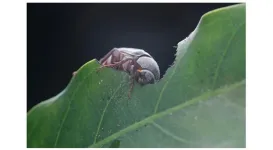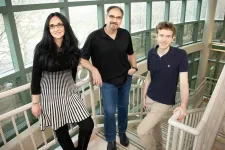(Press-News.org) Life on Earth runs on a 24-hour cycle as the planet turns. Animals and plants have built-in circadian clocks that synchronize metabolism and behavior to this daily cycle. But one beetle is out of sync with the rest of nature.
A new study, published Jan. 18 in Current Biology, looks at a beetle with a unique, 48-hour cycle. The large black chafer beetle, Holotrichia parallela, is an agricultural pest in Asia. Every other night, the female beetles emerge from the soil, climb up a host plant and release pheromones to attract males.
This mating behavior by the female beetles is under the control of a 48-hour, or “circa-bi-dian” clock, for reasons that remain mysterious. A team led by Walter Leal, professor of molecular and cellular biology at the University of California, Davis, and Jiao Yin at the Chinese Academy of Agricultural Sciences, Beijing, wanted to know if the male beetles’ ability to smell the females was also on a 48-hour clock.
Leal’s lab at UC Davis studies chemical sensing in insects. Many insects, from moths to mosquitoes, use scent to attract a mate. Insects “smell” with their antennae, which contain specialized receptors that react to specific chemicals wafting through the air.
Following pheromones
The team’s first step was to identify the gene in large black chafers for the receptor that reacts to the female pheromone, which has the seductive name L-isoleucine methyl ester, or LIME. The researchers initially cloned 14 candidate genes. A series of experiments led them to a gene called HparOR14 as the sex pheromone receptor — incidentally, the first such to be identified in a beetle species.
Having identified the receptor gene, they could measure levels of HparOR14 gene transcripts throughout the beetle’s life and its activity over 48 hours. They found that on “date night,” when females would be climbing plants to release scent, HparOR14 transcription was higher after dark. But receptor activity was low on the alternating days. (In a control experiment, the response to a chemical signal from damaged leaves, indicating food for the beetle, remained constant day after day.)
The results show that male chafer’s ability to detect the female sex pheromone does run on a 48-hour, circabidian cycle that matches the female mating behavior.
Why, and how, large black chafers have these 48-hour cycles is unknown. Circadian, 24-hour clocks are synchronized by cues that change over a 24-hour cycle — the most obvious being the rising or setting of the sun. But there are no 48-hour cues in nature, so exactly how the circabidian cycles of large black chafers are set — including how males and females can synchronize with each other, so they all know which night is date night — is a mystery still to be solved.
“Twenty-four hour rhythms in physiology and behavior are commonly observed in organisms from bacteria to humans, but observations of 48-hour rhythms in nature are rare,” said Professor Joanna Chiu, chair of the Department of Entomology and Nematology at UC Davis and an expert on circadian rhythms, who was not involved in the work. “This elegant study by Professor Leal and his collaborators has provided us with an in-depth description of how the circabidian rhythm of pheromone detection in this beetle is generated.”
Additional authors on the study are: Yinliang Wang, Huanhuan Dong, Yafei Qu, Jianhui Qin, Kebin Li, Yazhong Cao and Shuai Zhang, Chinese Academy of Agricultural Sciences, Beijing; Yuxin Zhou and Bingzhong Ren, Northeast Normal University, Changchun, China; and Chen Luo, Beijing Academy of Agriculture and Forestry Sciences. The work was supported by the National Key R&D Foundation of China; National Natural Science Foundation, China; and the Natural Science Foundation of Beijing.
END
For this beetle, ‘date night’ comes every other day
Researchers study anomalous 48-hour cycle of large black chafer beetle
2024-01-18
ELSE PRESS RELEASES FROM THIS DATE:
National Science Foundation taps NYU Tandon with $5 million grant to advance accessibility
2024-01-18
A team at NYU Tandon School of Engineering will kick off the second phase of an ambitious research project that aims to transform navigation and accessibility for many of the 285 million people with blindness and low vision (pBLV) worldwide.
The National Science Foundation (NSF) awarded the project a three-year $5 million grant last month.
Led by John-Ross Rizzo – an associate professor in NYU Tandon’s Biomedical Engineering department, associate director of NYU WIRELESS, affiliated faculty at the NYU Tandon Center for Urban Science and Progress (CUSP) and associate professor in the Department of Rehabilitation Medicine at NYU ...
Texas A&M AgriLife Research study may lead to novel obesity treatment
2024-01-18
MEDIA INQUIRES
WRITTEN BY
Laura Muntean
Paul Schattenberg
laura.muntean@ag.tamu.edu
paschattenberg@ag.tamu.edu
601-248-1891
210-859-5752
FOR ...
Semen microbiome health may impact male fertility
2024-01-18
You may have heard about the gut microbiome and its influence on a person’s overall health and well-being. It turns out that the same may hold true for the semen microbiome.
According to researchers from the Department of Urology at UCLA, the semen microbiota might play a crucial role in influencing sperm parameters and enhancing male fertility. Considering recent studies highlighting the microbiome’s significance in overall human health, researchers investigated the semen microbiome to understand its potential impact on male infertility. Exploring the functions of these microorganisms in semen could potentially pave the way for developing treatments targeted ...
South Florida’s nearshore reefs less vulnerable to ocean acidification, study finds
2024-01-18
South Florida’s Nearshore Reefs Less Vulnerable to Ocean Acidification, Study Finds
Results offer a glimmer of hope as climate change impacts coral reefs worldwide
Researchers studying South Florida’s coral reefs found that the region’s nearshore reefs and more sheltered inshore areas are less vulnerable to ocean acidification than previously thought – a major climate-related threat to coral reefs as ocean waters absorb more atmospheric CO2 from the burning of fossil fuels.
This new study, led by scientists at the University of Miami Rosenstiel School of Marine, Atmospheric, ...
Three University of Houston projects included in $17M+ funding for decarbonization and emissions research
2024-01-18
HOUSTON, January 18, 2024 – The U.S. Department of Energy (DOE) recently announced $17.4 million funding for 19 early-stage research projects focused on expanding clean energy technologies at colleges and universities across America. These projects will establish visiting scholars’ programs, create new academic curricula related to geosciences, and provide interdisciplinary training in humanities-driven science, technology, engineering, and mathematics fields.
The list includes three projects from the University of Houston, a Carnegie-designated Tier One Research University. Two of these explore the feasibility and benefit of repurposing ...
Knowing what dogs like to watch could help veterinarians assess their vision
2024-01-18
Ever wonder what kind of TV shows your dog might choose if they could work the remote control? New research from the University of Wisconsin–Madison’s School of Veterinary Medicine provides some answers, but the study was more interested in solving a longstanding problem in veterinary medicine than turning canine companions into couch potatoes.
According to Freya Mowat, veterinary ophthalmologist and professor in the School of Veterinary Medicine’s department of surgical sciences, researchers wanted to determine factors, including age and vision, that influence a dog’s ...
Household income and health insurance among factors in decision to withdraw life support after hemorrhagic stroke
2024-01-18
Living in a high-income neighborhood, having private health insurance, and being older are tied to an increased likelihood that life support will be withdrawn for people who have suffered severe bleeding in the brain, a new study shows.
Led by researchers at NYU Grossman School of Medicine, the study focused on the social and economic factors linked to the withdrawal of life support and related death after being hospitalized for intracerebral hemorrhages. Such bleeds, sometimes referred to as hemorrhagic stroke, often lead to swelling in the brain, which can put a patient into a coma and frequently ...
Xue lab at the CDI publishes groundbreaking insights into memory T cells in Nature Immunology
2024-01-18
The Xue Lab at the Hackensack Meridian Center for Discovery and Innovation (CDI) has made another breakthrough in better understanding, and potentially modulating, the immune system to fight diseases.
The insights into a specific protein and how it regulates the training and efficacy of central memory T cells are published by Hai-Hui (Howard) Xue, a member of the CDI, in the journal Nature Immunology.
The immunological implications could produce better vaccines and cancer treatments in the future, according to the Xue lab, which is also part of the Institute for Immunologic ...
Don’t look back: The aftermath of a distressing event is more memorable than the lead-up, study suggests
2024-01-18
Halfway through a true crime podcast, a morning commuter jerks the wheel to narrowly avoid a collision. When discussing the podcast with a coworker later that day, the driver can easily recall the details of the episode’s second half but retains only a blurry recollection of how it began.
A new study from psychologists at the Beckman Institute for Advanced Science and Technology suggests that we remember the moments immediately following a distressing episode more sharply than the moments leading up to it. Clarifying the relationship ...
FIFA World Cup ends with win for Argentina and COVID-19, new research finds
2024-01-18
TORONTO, Jan. 18, 2024 – The 2022 FIFA World Cup ended with a tight win for Argentina over France on penalties, but it was also a triumph for SARS-CoV-2 with a significant jump in the number of cases, some of which York University researchers say could have been prevented.
New research published today and led by York used the 2022 FIFA World Cup as a case study to help determine the best ways to mitigate virus spread and hospitalizations at mass gatherings in the future. A technique was used ...
LAST 30 PRESS RELEASES:
Making lighter work of calculating fluid and heat flow
Normalizing blood sugar can halve heart attack risk
Lowering blood sugar cuts heart attack risk in people with prediabetes
Study links genetic variants to risk of blinding eye disease in premature infants
Non-opioid ‘pain sponge’ therapy halts cartilage degeneration and relieves chronic pain
AI can pick up cultural values by mimicking how kids learn
China’s ecological redlines offer fast track to 30 x 30 global conservation goal
Invisible indoor threats: emerging household contaminants and their growing risks to human health
Adding antibody treatment to chemo boosts outcomes for children with rare cancer
Germline pathogenic variants among women without a history of breast cancer
Tanning beds triple melanoma risk, potentially causing broad DNA damage
Unique bond identified as key to viral infection speed
Indoor tanning makes youthful skin much older on a genetic level
Mouse model sheds new light on the causes and potential solutions to human GI problems linked to muscular dystrophy
The Journal of Nuclear Medicine ahead-of-print tip sheet: December 12, 2025
Smarter tools for peering into the microscopic world
Applications open for funding to conduct research in the Kinsey Institute archives
Global measure underestimates the severity of food insecurity
Child survivors of critical illness are missing out on timely follow up care
Risk-based vs annual breast cancer screening / the WISDOM randomized clinical trial
University of Toronto launches Electric Vehicle Innovation Ontario to accelerate advanced EV technologies and build Canada’s innovation advantage
Early relapse predicts poor outcomes in aggressive blood cancer
American College of Lifestyle Medicine applauds two CMS models aligned with lifestyle medicine practice and reimbursement
Clinical trial finds cannabis use not a barrier to quitting nicotine vaping
Supplemental nutrition assistance program policies and food insecurity
Switching immune cells to “night mode” could limit damage after a heart attack, study suggests
URI-based Global RIghts Project report spotlights continued troubling trends in worldwide inhumane treatment
Neutrophils are less aggressive at night, explaining why nighttime heart attacks cause less damage than daytime events
Menopausal hormone therapy may not pose breast cancer risk for women with BRCA mutations
Mobile health tool may improve quality of life for adolescent and young adult breast cancer survivors
[Press-News.org] For this beetle, ‘date night’ comes every other dayResearchers study anomalous 48-hour cycle of large black chafer beetle






